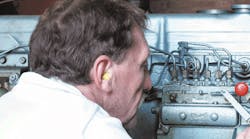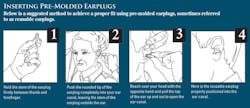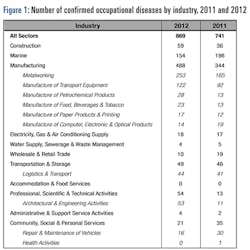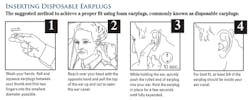Noise-induced hearing loss and tinnitus, or ringing in the ears, can occur from exposure to loud sound. The critical factors are the noise level, measured in decibels (dB), and the duration or how long the sound is heard. As the sound level increases, the length of time that a person safely can listen to the sound decreases. A one-time exposure to an intense, "impulse" sound – like gunfire – or repeated exposures to loud sounds 85 dBA and greater – like working around machinery noise all day – has the potential to rob people of precious hearing or cause permanent ringing in the ears.
The U.S. Bureau of Labor Statistics cites occupational hearing loss as the most commonly recorded occupational illness in manufacturing, and the second-most recorded work-related illness in the United States. Globally, the European Union, Asia and South American countries also list noise-induced hearing loss as one of the most common occupational diseases.
While excessive noise is present in many work environments, manufacturing industries record some of the highest rates of noise induced hearing loss globally. In the United States, the manufacturing sector showed an increase in noise-induced hearing loss cases from 344 in 2011 to 488 in 2012. More than half of the cases (52 percent) were from metalworking, according to the Workplace Health and Safety Institute. A recent study by the National Institute for Occupational Safety and Health revealed that the sectors with the highest risk for developing hearing loss from noise are 1) mining, quarrying and oil and gas extraction, 2) construction and 3) agriculture, forestry, fishing and hunting. Noise-induced hearing loss is so prevalent in the mining industry that almost 27 percent of workers have been diagnosed with hearing loss.
Employers Must Protect Workers
To protect workers from hazardous noise, employers are mandated to reduce occupational noise exposures and to provide personal protective equipment, or hearing protection devices (HPDs), when the noise cannot be lowered to acceptable limits. In the United States, HPDs must be measured in a standardized way on a small group of human subjects in an accredited laboratory. The amount of noise that is blocked is used to calculate a noise reduction rating (NRR), which must be printed on the product packaging. The NRR represents the optimal capability of the HPD when it is fit properly.
However, the typical workplace is quite different from the laboratory setting where the NRR measurements are conducted. Workers have to move around, wear other protective gear, experience changing temperatures in their environment and concentrate on getting their work done correctly. Not surprisingly, research has shown that employees typically get much less attenuation than the NRR indicates – sometimes only about one-half to one-third of the NRR.
As a general rule, earmuffs tend to be easier to fit correctly with little training compared to earplugs. Therefore, in general, the real world attenuation from earmuffs tends to come closer to the NRR than for earplugs.
Fit Testing Hearing Protection
How does an employer or employee know how much attenuation a given HPD is providing individual workers? A new technology called field attenuation estimation systems has the potential to answer this question. This technology consists of an individualized test completed on each worker, each ear and each earplug.The noise-reduction measurements made with this type of "fit-testing" can be used to help ensure that the worker is getting adequate protection from a given HPD by calculating a personal attenuation rating (PAR). If the PAR is too low, the worker can be coached on better fitting techniques, or can choose a different device that might fit better. What we've learned is that with earplugs, just like with respirators, we cannot judge the performance of the device on an individual just by looking at it. Validating the fit of a device is a powerful tool to help employees know how to wear hearing protectors properly and employers to know they are providing the best for their employees.
As noted above, one of the key reasons workers receive less-than-adequate protection is due to improper wear of hearing protection; for example, poorly inserted earplugs.
The diagram below illustrates poor, improper and proper fitting of user-formable earplugs, commonly called disposable earplugs or foam earplugs. With fit testing, the attenuation of the device objectively can be measured and a PAR assigned to each fit. If the PAR is too low, the employee can be taught how to better insert the HPD. Sometimes, a different HPD is needed to achieve the desired results.
Access to education on how to properly use hearing protection devices is important to help ensure that the issue of occupational-induced hearing loss is addressed. Providing personal information about the fit of HPDs better equips the worker to prevent attenuation leaks and benefits from properly used hearing protection.
Particularly for pre-molded earplugs, care must be taken when removing earplugs. Gently twist the earplug to break the acoustic seal before removing the earplug.
In the workplace, there is variation among individuals and types of hearing protection devices. Check the fit of the earplugs by gently pulling on the earplug; it should not move easily. If the earplug moves easily, remove it and re-insert it deeper into the ear canal making sure that one-fourth of the earplug is outside the ear.
Another important step to preventing hearing loss is to make a personal commitment to wear the appropriate hearing protection. An ongoing struggle for many employers is to ensure workers who should be wearing hearing protection actually are wearing it on the job, all the time. Ultimately, workers decide if they wear hearing protection correctly. Just recently, 3M launched a social campaign called the "Hearing Pledge." By taking the pledge at www.hearingpledge.com, workers can access educational resources and commit to wearing hearing protection.
Noise-induced hearing loss often goes undetected because there are no visible symptoms. It develops gradually over a long period of time, and isn't painful. By educating organizations and individual workers on how to properly utilize their HPDs, the gap between the NRR and the attenuation realized in the workplace may be narrowed, ultimately helping prevent hearing loss and tinnitus.
Laurie Wells is senior acoustics specialist, 3M, and Albert Khoo is business development manager, 3M Personal Safety Division.




